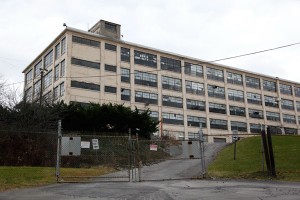Ithaca’s mayor-elect has big plans for the Emerson Power Transmission facility, with a controversial proposal to develop housing at the polluted building located off Route 96B.

Svante Myrick, Ithaca’s newly elected mayor, wants to develop the Emerson site into residential housing and the plant itself into a combined heat and power plant. However, the New York State Department of Environmental Conservation has determined that the area had been contaminated with trichloroethene, a recognized carcinogen.
Myrick said the plan isn’t necessarily his, but he sees it as an opportunity for Ithaca.
“It’s a vision that’s informed by the entire community,” Myrick said. “A lot of people have been talking about it and working on it. So it’s the plan that I will pursue, and it’s a plan that I’m excited about.”
Karen Cahill, an environmental engineer and the DEC project manager for the Emerson site, said TCE contamination of groundwater is nowhere near state groundwater standards.
“Levels that they currently have on site are quite high,” Cahill said. “In relation to the fivepart-per-billion [state standard], they have tens of thousands of part per billion TCE in the water.”
Cahill said the groundwater contamination has been monitored and treated by Emerson, a manufacturing company, as required by the state since 1994. The DEC required in 2009 that the company upgrade the groundwater treatment system in order to increase efficiency in the removal of TCE. But the amount of time it will take to reach state standards, Cahill said, is impossible to estimate.
“We’re seeing much greater efficiency with the new system,” she said. “But even with those, it’s still going to take some time.”
Walter Hang, president of Toxics Targeting, an environmental information-gathering firm, said the toxicity of the Emerson site extends beyond TCE.
“It isn’t just TCE contamination,” he said. “There are literally dozens of toxic chemicals, and the New York state authorities have determined that the site is a significant threat to the public health and environment, and that action is required.”
Hang said the remediation process has not been expedited, and that needs to be first priority.
“They’ve got to clean up the site,” he said. “They haven’t cleaned up the site for 25 years.”
Myrick estimated the clean-up effort might include an excavation of some of the land to fully eradicate the contamination.
“We’re going to have to actually get in there, dig up the soil, find out where the contamination is and remove it at the source in order to get it safe enough for people to live in,” he said.
Myrick said the entire process, even if expedited, is years away from completion.
“The actual, physical remediation will take time,” Myrick said. “The actual, physical construction, I would say that we are optimistically five years away from seeing anything on the Emerson site.”
Cahill said plans for developing the Emerson site are premature at this time, since the DEC determined the site can currently be used for industrial purposes only.
“A good portion of the site is wooded area, and we’ve encouraged them to possibly get that removed from the site as it is currently defined,” Cahill said.
Financially, the city cannot take on the South Hill clean-up and redevelopment alone, Myrick said.
“It’s going to have to be a joint effort between New York state, Emerson and a private developer,” he said. “There are people who have come forward and offered to take the lead, and they’re in talks right now.”
Christine Linder, a spokesperson for Emerson Power Transmission, said in an email that the company is dedicated to the clean-up of the site.
“Emerson continues to work closely with the agencies involved in the remediation work at the Emerson site on South Hill,” Linder said. “Emerson is committed to completing this work to the satisfaction of the New York State Department of Environmental Conservation and the New York State Department of Health.”
Myrick said the remediation and development of the Emerson site will not be ignored.
“It’s a top priority,” he said. “It’s something I’ll start work on right away and something the current mayor is already working on.”
Myrick said there is a sense of urgency to clean up the plant and to solve the city’s housing shortage.
“The opportunity to create housing on a site that will increase the walkability of the city while still preserving the residential neighborhoods we care about here is tremendous.”







